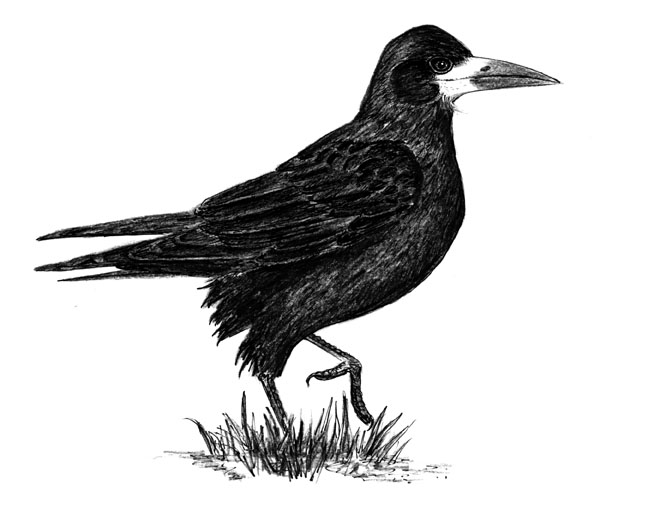
Dear Bird Folks,
In one of your past columns you wrote about the differences between grackles and crows, but I want to know about Rooks. We saw Rooks in Ireland last summer and they reminded us of grackles. Are Rooks the European cousins of our grackles?
– Andrea, Wilton, CT
Thank you, Andrea,
I’m really glad you asked this question. It’s not that I’ve been feeling a sudden need to write about Rooks, but usually the only questions I receive in late November are about turkeys and I hate that. Writing about turkeys this time of year is just too depressing. Last year the gobbles of some forty-five million turkeys fell silent on Thanksgiving and it’s totally sad. I blame those stupid Pilgrims. Why couldn’t they have eaten mac & cheese or PB & J at the first Thanksgiving? Both of those food items are far yummier and there are no bones to deal with. Just think how less gory Thanksgiving would be if the Plymouth Bay Colony had been founded by a Mayflower filled with preschoolers instead of barbaric Pilgrims. When Apple invents a time machine that’s the first thing I’m going to change.
Okay, I’m over that; now on to the Rooks. Nope, Rooks aren’t our grackles’ European cousins. Grackles are blackbirds. Their cousins are Red-winged Blackbirds, cowbirds, meadowlarks and believe it or not, orioles. Yes, those squawky old grackles, the birds everyone complains about, are closely related to the handsome Baltimore Orioles, the birds everybody loves. This proves that we can’t judge one species based on the behavior of its relatives. (Just ask Billy Bulger.) Rooks, on the other hand, are related to crows, ravens, jays and magpies. And while I regularly have to listen to grumblings about crows, I’ve never heard anyone say a bad word about Rooks. That’s probably because Rooks live in Europe and Asia and aren’t found on this side of the Atlantic. They’ve avoided North America ever since they heard about what happened to the turkeys.
Rooks are fairly large birds, about the size and shape of our American Crows. But Rooks aren’t as black as American Crows. Their feathers have a slight purple sheen to them and perhaps that is what made you think they are related to grackles. Rooks aren’t as sleek as crows either. Their feathers are often fluffed out, especially near their legs, making them look like they are wearing pants designed by MC Hammer. An adult Rook also has one other field mark that makes it stand apart from crows. It lacks feathers at the base of its bill, exposing an area of grayish/white skin. This gives the bird the look of an old, graying dog, or of someone who has been eating sugared doughnuts.
Again, like crows, Rooks are omnivorous. They’ll eat just about anything, including insects, grain, nuts and sugared doughnuts. However, they tend to eat far more grains and nuts than crows do (which gives me hope that eventually they’ll make the switch and become total vegetarians). Rooks are highly social birds. If you see one, you are likely to see twenty. At night they roost in larger flocks and during the breeding season they nest in big colonies. Here’s some trivia for you. Wanna guess what a nesting colony of Rooks is called? That’s right, a “rookery.” This term has been applied to colonies of many creatures, including herons, penguins and seals, but its origin can be traced to Rooks. Unfortunately, the birds failed to copyright the name and have been rooked out of untold millions in royalties.
In addition to being sociable, Rooks are considered one of our smartest birds, perhaps even smarterer than monkeys. In one test, Rooks needed to use an available tool (stone, wire or stick) in order to retrieve a bit of food from a container. The birds chose the correct tool for the job 97% of the time and they did it on the first try. There was no trial and error or guessing. The birds were able evaluate the situation and pick the right tool on the first try. When I’m fixing someone’s bird feeder I have to fumble with at least five different wrenches before I ultimately get the right one. Heck, it takes me several trips to the store before I finally buy the proper size batteries for the TV remote control. I’ll bet Rooks don’t have that trouble.
Since Rooks have lived alongside humans for centuries, it’s not surprising that they have been included in local superstitions. Some cultures believed the birds could predict the weather, while others considered it a bad omen when Rooks abandoned their rookery. It was also thought that Rooks escorted souls to heaven. (Now do you see why I try to stay on the birds’ good side?)
I hope you had fun in Ireland, Andrea. It’s one of my favorite countries to visit. I especially like it because it’s one of the few places I can go where I actually look like I have a tan. I also like Ireland because they have lots of different birds there, including Rooks. It’s too bad Rooks aren’t normally found in our country although there may be some in New York. I think I heard recently that people were cheering the Rooks on Wall Street. Or was it jeering the crooks on Wall Street? I’m not sure. Maybe it’s time to get my ears tested.